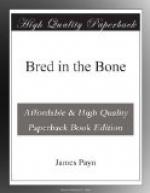by reason of its profuse hospitalities; and sometimes
“Liberty Hall,” on account of its license;
otherwise it was never, called any thing but Crompton;
never Crompton Hall, or Crompton Park—but
simply Crompton, just like Stowe or Blenheim.
And yet the park at Crompton was as splendid an appanage
of glade and avenue, of copse and dell, as could be
desired. It was all laid out upon a certain plan—somewhere
in the old house was the very parchment on which the
chase was ordered like a garden; a dozen drives here
radiated from one another like the spokes of a wheel,
and here four mighty avenues made a St. Andrew’s
cross in the very centre—but the area was
so immense, and the stature of the trees so great,
that nothing of this formality could be observed in
the park itself. Not only were the oaks and beeches
of large, and often of giant proportions, but the
very ferns grew so tall that whole herds of fallow
deer were hidden in it, and could only be traced by
their sounds. There were red deer also, almost
as numerous, with branching antlers, curiously mossed,
as though they had acquired that vegetation by rubbing,
as they often did, against the high wooden pale—itself
made picturesque by age—which hedged them
in their sylvan prison for miles. Moreover, there
were wild-cattle, as at Chartley (though not of the
same breed), the repute of whose fierceness kept the
few public paths that intersected this wild domain
very unfrequented. These animals, imported half
a century ago, were of no use nor of particular beauty,
and would have dwindled away, from the unfitness of
the locality for their support, but that they were
recruited periodically, and at a vast expense.
It was enough to cause their present owner to strain
every nerve to retain them, because they were so universally
objected to. They had gored one man to death,
and occasionally maimed others, but, as Carew, to
do him justice, was by no means afraid of them himself,
and ran the same risk, and far oftener than other
people, he held he had a right to retain them.
Nobody was obliged to come into his park unless they
liked, he said, and if they did, they must “chance
a tossing.” The same detractors, whose opinion
we have already quoted, affirmed that the Squire kept
these cattle for the very reason that was urged against
their existence; the fear of these horned police kept
the park free from strangers, and thereby saved him
half a dozen keepers.
That his determination in the matter was pig-headed and brutal, there is no doubt; but the Squire’s nature was far from exclusive, and the idea of saving in any thing, it is certain, never entered into his head. The time, indeed, was slowly but surely coming when the park should know no more not only its wild-cattle, but many a rich copse and shadowy glade. Not a stately oak nor far-spreading beech but was doomed, sooner or later, to be cut down, to prop for a moment the falling fortunes of their spendthrift owner; but at the time of which we speak there was




